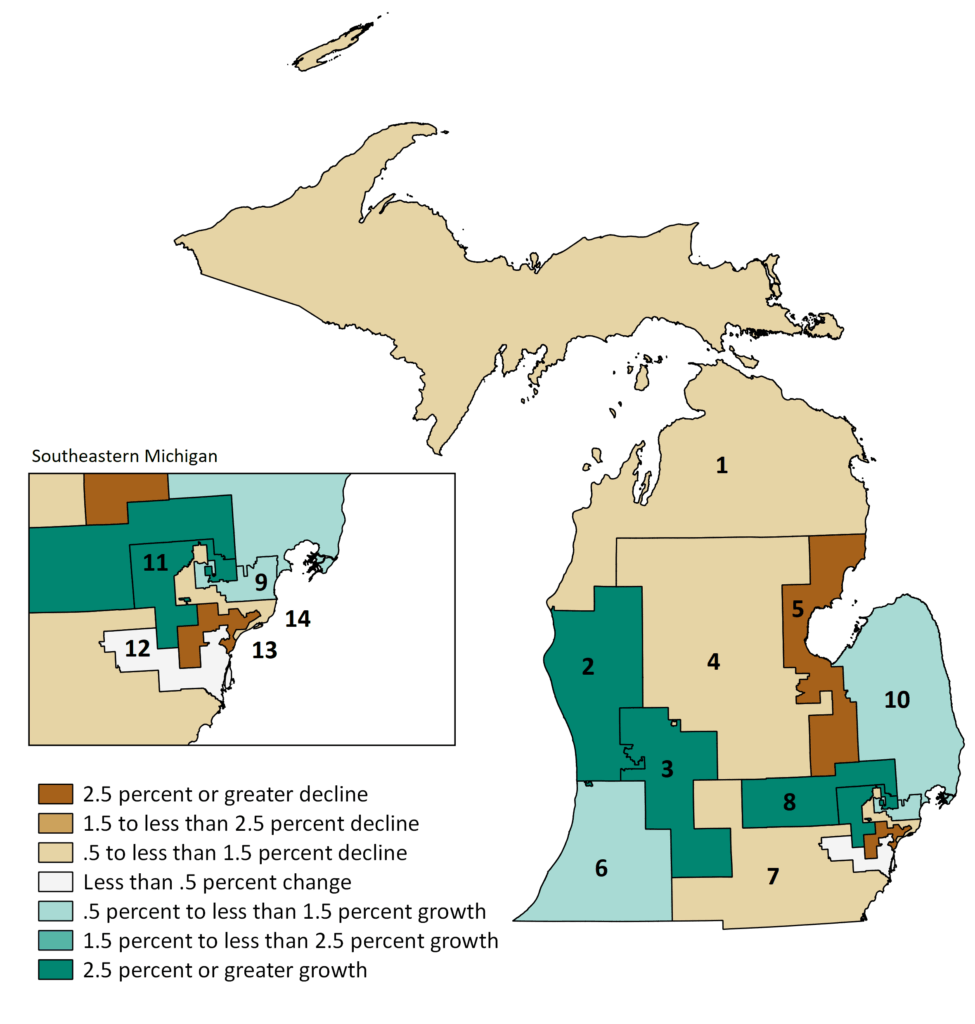In a nutshell:
- Michigan is likely to lose a seat in the 435-member U.S. House of Representatives following the 2020 Census.
- Slow state population growth is a major factor in this.
- Urban areas are growing while most rural areas are losing population.
State population growth, or lack thereof, combined with population shifts within states can have significant impacts on congressional districts. Using data from the upcoming 2020 U.S. Census, every state will redraw their congressional and state legislative maps in 2021.
In recent rounds, the reapportionment process has not been kind to Michigan. After the 1970 Census, the state had 19 representatives in the U.S. House of Representatives. Every decade since, however, Michigan has lost at least one congressional seat; the state currently has 14 representatives in the U.S. House. And this trend seems likely to continue with the next census.
Losing a Seat in the U.S. House
While Michigan’s population increased by nearly two percent annually from 1900 to 1960, it has grown much slower since. This slowdown, combined with continued population growth nationally, is why Michigan has lost those five congressional seats in the last 50 years.
Between 2000 and 2010, the state actually lost population, the only one to do so. While the decline has reversed and the state is now gaining residents, Michigan’s population has only increased 0.8 percent between 2010 and today, tied for the 8th slowest rate in the country. At the same time that Michigan is basically treading water, some Western and Southern states have grown by more than 10 percent over the same period. As a result, recent projections have the state losing another congressional seat in 2020.
Michigan is not the only state in the region experiencing a prolonged decline. Ohio, which was apportioned 24 seats at its peak, currently has 16 representatives and could lose one more. Pennsylvania, with 30 seats in 1950, could fall to 17 in 2020. Minnesota and Illinois are also expected to lose a seat. Wisconsin and Indiana, while not expected to lose a seat, are trending downward over the last several decades. This shows how radically the nation’s internal migration has shifted in recent decades; the winners have been states in the west and especially the south.
Complications Within the Redistricting Process
The loss of another congressional seat will make an already challenging redistricting process more complicated. As discussed in our report Exploring Michigan’s Urban/Rural Divide, population growth in the state has been somewhat dichotomous. Cities and suburbs, particularly Grand Rapids and surrounding areas, and the regions surrounding Detroit, Lansing, and Ann Arbor, have grown over the current period, while most rural areas have seen their populations decline.
These trends are present within our current congressional districts. Map 1 shows that districts within the high growth areas of the state have experienced population growth that matches – or even exceeds – the national average since 2010. Congressional districts containing largely rural populations actually saw their population shrink.
Map 1: Population Changes from 2010 to 2016: Michigan Congressional Districts

Source: American Community Survey one-year estimates.
While these trends will not radically change the redistricting process, the combination of the state’s population moving towards cities, and the loss of a congressional seat, will create challenges. Nearly 40 percent of the state’s population resides in the Wayne-Oakland-Macomb area, enough for five full congressional districts.
Districts in Southeastern Michigan, which already cover significantly smaller areas, will continue to shrink in area. Districts around Grand Rapids will continue to become more compact as well, as Kent County has grown by more than seven percent so far this decade. More rural districts, like those in the Upper Peninsula, will expand in coverage.
Our recent report on gerrymandering in Michigan found that the current district maps show signs of partisan bias. Losing a congressional district forces choices with gerrymandering implications: Which district will be dissolved? How will populations be redistributed? How those decisions are made can either leave most districts relatively similar to how they are now, or could be used to increase or reduce the advantages present in the current maps. Either way, it will have a decade of impact on Michigan elections.
